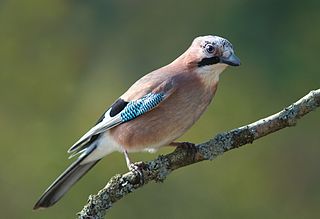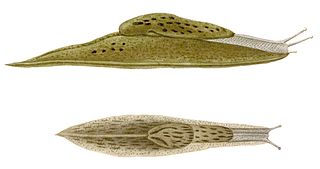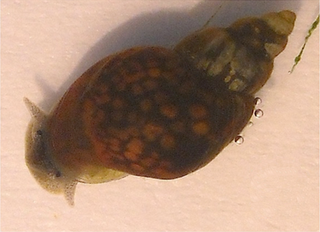
The Eurasian jay is a species of passerine bird in the crow family Corvidae. It has pinkish brown plumage with a black stripe on each side of a whitish throat, a bright blue panel on the upper wing and a black tail. The Eurasian jay is a woodland bird that occurs over a vast region from western Europe and north-west Africa to the Indian subcontinent and further to the eastern seaboard of Asia and down into south-east Asia. Across this vast range, several distinct racial forms have evolved which look different from each other, especially when comparing forms at the extremes of its range.

The brown-mantled tamarin, also known as Spix's saddle-back tamarin, is a species of saddle-back tamarin. This New World monkey is found in the Southern American countries of Bolivia, Brazil and Peru. This omnivorous member of the Callitrichidae family is usually found in smaller groups ranging between 4 and 15 individuals. This species communicates vocally and largely rely their olfactory system. The brown-mantled tamarin is considered as a species of Least Concern by the International Union for Conservation of Nature, despite a decreasing population and being threatened by poaching, habitat loss and capture for the illegal pet trade.

Argonauta hians, also known as the winged argonaut, muddy argonaut or brown paper nautilus, is a species of pelagic octopus. The common name comes from the grey to brown coloured shell. The Chinese name for this species translates as "Grey Sea-horse's Nest". The female of the species, like all argonauts, creates a paper-thin eggcase that coils around the octopus much like the way a nautilus lives in its shell. The eggcase is characterised by a wide keel that gives it a square appearance, few rounded tubercles along the keel, and less than 40 smooth ribs across the sides of the shell. The shell is usually approximately 80 mm in length, although it can exceed 120 mm in exceptional specimens; the world record size is 121.5 mm.

The flamingo tongue snail is a species of small but brightly colored sea snail, a marine gastropod mollusk in the family Ovulidae, the cowry allies.

Theodoxus fluviatilis, common name the river nerite, is a species of small freshwater and brackish water snail with a gill and an operculum, an aquatic gastropod mollusk in the family Neritidae, the nerites.

Ovulidae, common names the ovulids, cowry allies or false cowries, is a family of small to large predatory or parasitic sea snails, marine gastropod molluscs in the superfamily Cypraeoidea, the cowries and the cowry allies.

The Kerry slug or Kerry spotted slug is a species of terrestrial, pulmonate, gastropod mollusc. It is a medium-to-large sized, air-breathing land slug in the family of roundback slugs, Arionidae.

The wildlife of Libya is spread over the Mediterranean coastline and encompasses large areas of the Saharan desert. The protection of wildlife is provided through appropriate legislation in seven national parks, five reserves, 24 protected areas, two wetlands under Ramsar Convention, and also in other areas. Apart from these, there are also five UNESCO World Heritage Sites related to culture. The most important national parks are the El-Kouf National Park and Karabolli National Park. The well known nature reserves are the Benghazi Reserve and the Zellaf Reserve. The wildlife species recorded in the country are 87 mammals and 338 species of birds.

The African giant shrew is a species of white-toothed shrew. It also is known as, Mann's musk shrew, Euchareena's musk shrew, or Olivier's shrew. It is native to Africa, where it has a widespread distribution and occurs in many types of habitat. Its natural habitats are subtropical or tropical dry forest, subtropical or tropical moist lowland forest, subtropical or tropical moist montane forest, dry savanna, moist savanna, arable land, rural gardens, urban areas, and heavily degraded former forest. In the Nile Valley it is found near human habitation, where it is considered to be a pest. It is a common species and is listed by the International Union for Conservation of Nature as being of "least concern".

Parmacella is a genus of air-breathing land slugs, terrestrial gastropod mollusks in the family Parmacellidae.

Onchidoris bilamellata, common name the rough-mantled doris, is a species of sea slug, a dorid nudibranch, a shell-less marine gastropod mollusk in the family Onchidorididae.

Cryptella canariensis is a species of air-breathing land semislug with a small shell, a terrestrial pulmonate gastropod mollusk in the family Parmacellidae. This species is also known as Parmacella canariensis.

Scutus unguis, common name the northern duck's bill, is a species of large sea snail or limpet, a marine gastropod mollusk in the family Fissurellidae, the keyhole limpets and slit limpets.
Parmacella gervaisii is an extinct species of air-breathing land snail, a terrestrial pulmonate gastropod mollusk in the family Parmacellidae.

Parmacella valenciennii is a species of air-breathing land slug, a terrestrial pulmonate gastropod mollusk in the family Parmacellidae.
Parmacella festae is a species of air-breathing land snail, a terrestrial pulmonate gastropod mollusk in the family Parmacellidae.
Parmacella deshayesi is a species of air-breathing land snail, a terrestrial pulmonate gastropod mollusk in the family Parmacellidae.

Galba schirazensis is a species of air-breathing freshwater snail, an aquatic pulmonate gastropod mollusk in the family Lymnaeidae, the pond snails.

Coriocella nigra is a species of sea snail, a marine gastropod mollusk in the family Velutinidae. An Indo-Pacific species, it lives on rocks at depths of up to 15 m. It is up to 10 cm long and has an internal shell; body color is black or brown. C. nigra is probably a predator of tunicates.
















